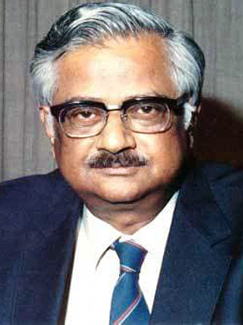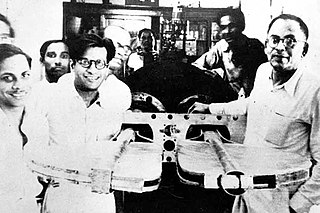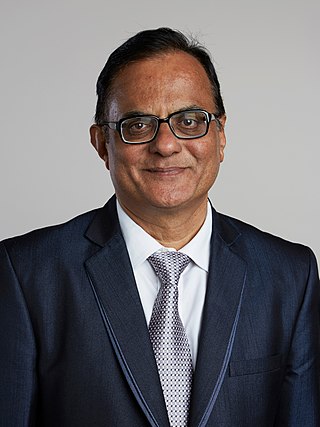Ganeshan Venkataraman | |
|---|---|
| Born | 6 October 1932 Madurai, Tamil Nadu, India |
| Occupation(s) | Condensed matter physicist Writer |
| Awards | Padma Shri UGC Sir C. V. Raman Award INSA Indira Gandhi Prize |
Ganeshan Venkataraman is an Indian condensed matter physicist, writer and a former vice chancellor of the Sri Sathya Sai University. [1] An elected fellow of the Indian National Science Academy, [2] and the Indian Academy of Sciences, [3] Venkataraman is a recipient of Jawaharlal Nehru Fellowship, Sir C. V. Raman Prize of the University Grants Commission and the Indira Gandhi Prize for Popularisation of Science of the Indian National Science Academy. [2] The Government of India awarded him the fourth highest civilian award of Padma Shri in 1991. [4]
Venkataraman was born on 6 October 1932, at Madurai in the south Indian state of Tamil Nadu. [3] After his post graduation, he joined Bhabha Atomic Research Centre (BARC) and worked at various stations including the Indira Gandhi Centre for Atomic Research, Kalpakkam, [5] where he served as the director of the Physics, Electronics and Instrumentation Group. [2] During this period, he pursued his doctoral research and secured a doctoral degree (PhD) in condensed matter physics in 1966 from the University of Mumbai. [2] Later, he was appointed as the director of Advanced Numerical Research and Analysis Group (ANURAG) of the Defence Research and Development Organisation (DRDO). [2] After superannuation from government service, he served as the vice chancellor and honorary professor of the Sri Sathya Sai University. [1]
Venkataraman, a distinguished professor of DRDO, has done advanced research in subjects such as neutron scattering, lattice dynamics, mechanical properties of matter, non-crystalline state, neutral networks and image processing. His contributions are reported in the design of Very Large Scale Integrated (VLSI) Circuits and its technology transfer. Apart from the scientific monographs like Dynamics of Perfect Crystals and Beyond the Crystalline State, he has also published several books such as, Journey into light: life and science of C.V. Raman, [6] A Hot Story, [1] Bhabha and His Magnificent Obsessions [7] and Saha and His Formula. [5] He is also a former member of the editorial board of Pramana, [8] a reputed journal of Physics [2] and has delivered several keynote addresses and lectures. [9] [10]
The Indian Academy of Sciences elected Venkataraman as their Fellow in 1974. [3] The Indian National Science Academy followed suit by honouring him with elected Fellowship in 1977. [2] He has also been a Jawaharlal Nehru Fellow (1984–86) and is a Fellow of the Materials Research Society of India. [2] The Government of India awarded him the civilian honour of the Padma Shri in 1991. [4] The same year, he received the Sir C. V. Raman Award of the University Grants Commission. [2] The Indian National Science Academy awarded him the Indira Gandhi Prize for Popularisation of Science in 1994. [2]

Raja Ramanna was an Indian physicist who is best known for his role in India's nuclear program during its early stages.

Homi Jehangir Bhabha, FNI, FASc, FRS, Hon.FRSE was an Indian nuclear physicist who is widely credited as the "father of the Indian nuclear programme". He was the founding director and professor of physics at the Tata Institute of Fundamental Research (TIFR), as well as the founding director of the Atomic Energy Establishment, Trombay (AEET) which was renamed the Bhabha Atomic Research Centre in his honour. TIFR and AEET served as the cornerstone of the Indian nuclear energy and weapons programme. He was the first chairman of the Indian Atomic Energy Commission and secretary of the Department of Atomic Energy. By supporting space science projects which initially derived their funding from the AEC, he played an important role in the birth of the Indian space programme.

The Homi Bhabha National Institute (HBNI) is an Indian deemed university established by the Department of Atomic Energy, which unifies academic programmes of several of its constituent institutions. Deemed universities in India have been divided in three categories by the Ministry of Human Resource Development (MHRD) and HBNI has been placed in category 'A', highest of the three categories. Homi Bhabha National Institute, Mumbai and its Constituent Units are the institutions of excellence as per section 4(b) of "The Central Education Institutions Act, 2006".

Rajagopala Chidambaram is an Indian Physicist who is known for his integral role in India's nuclear weapons program; he coordinated test preparation for the Pokhran-I (1975) and Pokhran-II (1998).

Sivaramakrishna Chandrasekhar FNA, FRS was an Indian physicist who won the Royal Medal in 1994. He was the founder-president of the International Liquid Crystal Society.

Prafullachandra Natwarlal Bhagwati was the 17th Chief Justice of India, serving from 12 July 1985 until his retirement on 20 December 1986. He introduced the concepts of public interest litigation and absolute liability in India, and for this reason is held, along with Justice V. R. Krishna Iyer, to be a pioneer of judicial activism in the country. He is the longest-served supreme court judge in India.
Padmanabhan Krishnagopala Iyengar, was an Indian nuclear physicist who is widely known for his central role in the development of the nuclear program of India. Iyengar previously served as the director of BARC and former chairman of the Atomic Energy Commission of India, he raised his voice and opposition against the nuclear agreement between India and the United States and expressed that the deal favoured the United States.

Bikash Sinha was an Indian physicist who was active in the fields of nuclear physics and high energy physics. Sinha was the director of the Saha Institute of Nuclear Physics and Variable Energy Cyclotron Centre and the chairman of the Board of Governors of the National Institute of Technology, Durgapur in June 2005. He was also a member of scientific advisory board to the Prime Minister of India.

Basanti Dulal Nagchaudhuri was an Indian physicist and academic, and a scientific advisor to the Government of India. He is known as one of the pioneers of nuclear physics in India. While serving as the Director General (1970-1974) to the Defence Research and Development Organisation (DRDO), he played influential role in Pokhran-I, India's first successful Nuclear bomb test on 18 May 1974. He also initiated the first feasibility studies on India's ballistic missile program.
Ranjan Roy Daniel was an Indian Nagercoil born physicist who worked in the fields of cosmic rays and space physics, and remained Director Chairman of Tata Institute of Fundamental Research. He also served as an advisor to the prime minister of India, Indira Gandhi in 1976. He worked in the field of cosmic rays with Homi Jehangir Bhabha for 23 years.

Ajay Kumar Sood is an Indian physicist and researcher currently serving as the 4th Principal Scientific Adviser to the Government of India.
Chaitanyamoy Ganguly is an Indian nuclear scientist and a former head of the Nuclear Fuel Cycle and Materials Section of the International Atomic Energy Agency (IAEA), credited with many innovations in the field of nuclear material science. He was honored by the government of India in 2002, with the fourth-highest Indian civilian award of Padma Shri.

Valangiman Subramanian Ramamurthy is an Indian nuclear physicist with a broad range of contributions from basic research to Science and Engineering administration.Prof.Ramamurthy started his career in Bhabha Atomic Research Centre, Mumbai in the year 1963. He made important research contributions in the area of nuclear fission, medium energy heavy ion reactions, statistical and thermodynamic properties of nuclei and low energy accelerator applications. During the period 1995-2006, Prof.Ramamurthy was fully involved in Science administration as Secretary to Government of India, Department of Science and Technology, (DST), New Delhi.Other important assignments held by him include Director, Institute of Physics, Bhubaneswar, (1989-1995), DAE Homi Bhabha Chair in the Inter-University Accelerator Centre, New Delhi (2006-2010), and Director of the National Institute of Advanced Studies, Bengaluru (2009-2014). He is a former chairman of the Recruitment and Assessment Board of the Council of Scientific and Industrial Research and has served as a member of the design team of the first Indian nuclear experiment in Pokhran on 18 May 1974. The Government of India awarded him the third highest Indian civilian honour of Padma Bhushan in 2005.
Vishnu Ganesh Bhide (1925–2006) was an Indian physicist and educationist, known for his pioneering work on Mossbauer spectroscopy and his contributions to science education in India. He was the scientific advisor to the Government of India during 1973-75 and a member of the International Commission on the Applications of Mossbauer Effect. The Government of India awarded him the fourth highest civilian honour of the Padma Shri in 1992.
Satinder Kumar Sikka was an Indian nuclear condensed matter physicist, crystallographer and a former Scientific Secretary to the Principal Scientific Advisor of the Government of India. He was known to have played a crucial role, along with Raja Ramanna, Rajagopala Chidambaram and Basanti Dulal Nagchaudhuri, in the design and development of a Hydrogen Bomb by India, which was tested at the Pokhran Test Range in May 1998, under the code name, Operation Shakthi. He was also involved in the Smiling Buddha tests, conducted in 1974. He was awarded the fourth highest civilian award of the Padma Shri, by the Government of India, in 1999.
Sekharipuram Narayaniyer Seshadri (1937–1986) was an Indian control engineer and the head of the Reactor Control Division of the Bhabha Atomic Research Centre. He established the control systems for the Satellite Receiving Station at Arvi, near Pune and the Ooty Radio Telescope. Subsequent to the bombing of Air India Flight 182 in June 1985, he conducted the examination of the cockpit voice recorder and air traffic control tapes.
Virendra Singh is an Indian theoretical physicist and a former C. V. Raman chair professor and director of the Tata Institute of Fundamental Research (TIFR). Known for his research in high energy physics, Singh is an elected fellow of all the three major Indian science academies - Indian National Science Academy, Indian Academy of Sciences and National Academy of Sciences, India as well as The World Academy of Sciences. The Council of Scientific and Industrial Research, the apex agency of the Government of India for scientific research, awarded him the Shanti Swarup Bhatnagar Prize for Science and Technology, one of the highest Indian science awards, for his contributions to Physical Sciences in 1973.
Nivrathi Suryanarayanashastry Satya Murthy was an Indian physicist and the head of the Nuclear Physics Division of the Bhabha Atomic Research Centre. Known for his research in molecular reaction dynamics, Murthy was an elected fellow of the Indian National Science Academy, National Academy of Sciences, India and Indian Academy of Sciences. The Council of Scientific and Industrial Research, the apex agency of the Government of India for scientific research, awarded him the Shanti Swarup Bhatnagar Prize for Science and Technology, one of the highest Indian science awards, for his contributions to physical sciences in 1980.
Narendra Kumar was an Indian theoretical physicist and a Homi Bhaba Distinguished Professor of the Department of Atomic Energy at Raman Research Institute. He was also an honorary professor at Jawaharlal Nehru Centre for Advanced Scientific Research.
Chokkanathapuram Venkataraman Sundaram was an Indian chemical metallurgist, best known for the commissioning of the Fast Breeder Test Reactor at Kalpakkam. He was the director of the Indira Gandhi Centre for Atomic Research (IGCAR). He was a recipient of the Sanjay Gandhi Award for Science and Technology as well as the National Metallurgists Day Award and an elected fellow of the Indian National Science Academy, the Indian Academy of Sciences and the Indian National Academy of Engineering. The Government of India awarded him the Padma Bhushan, the third highest civilian award, in 1986.